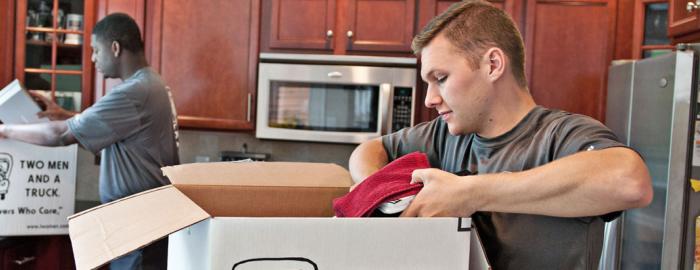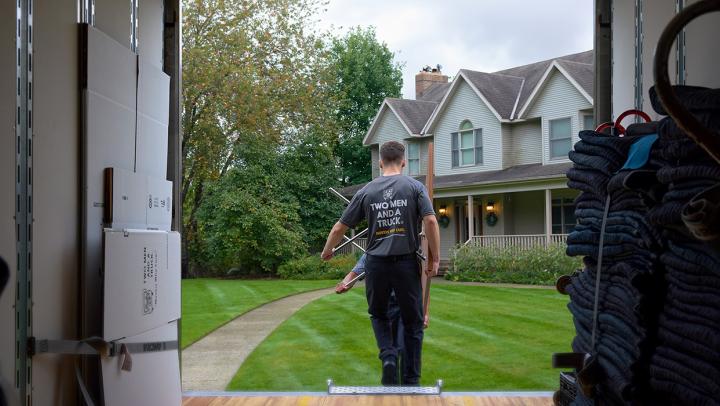With the right preparation, moving a dishwasher can be done efficiently and with low stress. Whether you’re moving to a new home or replacing an old dishwasher, follow these guidelines to safely disconnect your dishwasher and ensure it arrives at its destination in perfect condition.
What You Need
-
Appliance Dolly
For better leverage instead of having to carry the dishwasher.
-
Ratchet Straps
To secure the dishwasher in place when moving.
-
Crescent Wrench
For adjust the leveling feet on the dishwasher.
-
Screwdriver (Phillips and flathead)
For unscrewing parts on the dishwasher.
-
Moving blankets
To prevent scratches on your dishwasher during transit.
-
Duct Tape
To secure the water lines and any wires sticking out on the dishwasher.
-
Bucket
To catch any water that leaks out of the water line.
Step-by-Step Instructions
-
1Step 1Turn off power supply
The very first thing you need to do before moving your dishwasher is to disconnect the dishwasher from the power and water supply. A dishwasher is hooked up to both live electrical currents and running water; hence a water valve as well as an electrical power switch should be turned off to minimize risks. If your dishwasher is hardwired, go to the circuit breaker and switch to power off for the kitchen. For dishwashers that only need to be plugged into an outlet, just pull the plug from the outlet
-
2Step 2Turn off water supply
Locate the shutoff valve, typically found under the kitchen sink. This valve connects the dishwasher to the water supply line. Turn the valve clockwise to close it, ensuring the water flow stops. Afterward, run the dishwasher briefly to confirm that no water enters. If there’s no dedicated valve, you may need to turn off the main water supply to your home.
-
3Step 3Disconnect the water
After shutting down the power and water supply, we move to the next step of disconnecting the water and drain lines. Use a crescent wrench to grip the water supply line from the dishwasher to disconnect it. However, don’t forget to place a bucket underneath the line as there will definitely be a few remnants of water leaking. The drain line can usually be spotted with the water hose connected to the left side of the unit, and this should also be gently removed. Treat these lines with care.
-
4Step 4Remove the electrical connections
With the plumbing taken care of, it’s now time to work on the electrical. Use a screwdriver to unscrew the kick plate from the bottom of the dishwasher. You will then want to disconnect the electrical hookups. Locate the electrical box and unscrew the black/white wires, and ground connections. If your dishwasher is not hardwired, simply unplug it. Make sure you place all the screws and connectors in a ziploc bag with appropriate tags to facilitate quick reassembly of the dishwasher in your new house.
-
5Step 5Remove the dishwasher from the cabinet
To take out the dishwasher, open the door and look for screws towards the top that are drilled in to secure it’s position. Most dishwashers are secured to the countertop or cabinet with mounting brackets. Use a screwdriver to remove these screws holding the dishwasher in place. Using a crescent wrench, lower the leveling feet on the left and right side of the dishwasher so they don’t catch on the floor when moving. Carefully slide the dishwasher out of the cabinet.
-
6Step 6Secure hoses and cords
When the dishwasher is out of its space, remember that all cords, wires, and hoses need to be attached to it so that they do not get entangled with one another during the move. Duct tape or zip ties can be used to bind the water supply line, drain hose, and also the electric cords together. This step helps keep everything organized and minimizes the chances of anything being caught in moving parts and getting damaged.
-
7Step 7Load the dishwasher onto the dolly
Now that the dishwasher has been freed and is prepared to be moved, gently lean the dishwasher backward and insert the appliance dolly at the back. Secure the dishwasher on the dolly tightly using ratchet straps. It allows you to shift around any busy areas like corners, stairs, or long hallways quite easily without getting worried about an accident. During the whole duration of moving the dishwasher, it will be crucial to ensure that the appliance is upright to protect the internal parts including the pump and motor.
-
8Step 8Move your dishwasher
With the dishwasher strapped on to the dolly, move it into the moving truck with great care. Maintain the upright position of the dishwasher while putting it into the truck to avoid any damage, using a ramp if possible to make it easier. After the washer has been loaded onto the truck tightly bind it with more ratchet straps to avoid shifting during transit.
-
9Step 9Reinstall your dishwasher
Now that you’re in your new place, it’s time to offload your dishwasher and reinstall it. Reconnect the water and drain lines, affix the appliance to the counter, and turn the power back on. Your dishwasher is ready to go!
Want to move your dishwasher without the stress? Contact TWO MEN AND A TRUCK® today and we’ll give you a free quote and plan your move together! We’re ready when you are!

Thinking of Moving Yourself?
Think Again!
While moving yourself may seem less expensive... the costs add up.
Do-It-Yourself Moving Costs:
- Truck Rental
- Mileage
- Fuel Charge
- Additional Insurance
- Equipment Rental
(straps, rope, furniture pads, bungee cords, stretch wrap, dollies, etc.)
- Time
- Boxes & Packing Supplies
- Possible Damages
(belongings, relationships, & injuries)
- Recruiting Friends to Help
- Food & Beverages
- Chiropractor Visits
- Packing a Truck
- Learning How to Maneuver a Moving Truck
- Broken Promises
Call TWO MEN AND A TRUCK
We can move as much or as little as you need while fitting your schedule & budget!






